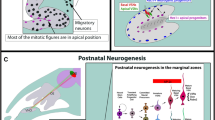Abstract
The present study was conducted to examine the survival and development of intracerebral transplanted neonatal rat vomeronasal organs (VNs). Complete neonatal (P5–P10) VNs were transplanted into the parietal cortex region of littermates and examined at 10–100 days by light microscopy. The VN survived and was organized into a series of vesicles lined by respiratory and/or sensory epithelia. Sensory neurons grew long axons that fasciculated and invaded the surrounding brain parenchyma. The newly developed axons did not prefer a specific brain region. The axons developed a complex fiber plexus either at the interface between transplant and host tissue or deep within the host brain parenchyma. Vomeronasal axons consistently formed glomerular-like structures within the fiber plexus. Our results suggest that glomerular formation is not dependent on specific target or length of axon development, but rather on a set of complementary axons that display mutual recognition.
Similar content being viewed by others
References
Altner H, Mueller W (1968) Elektrophysiologische and electronmikroscopische Untersuchungen an der Reichschleimhaut des Jacobsonschen Organ von Eidechsen (Lacerta). Z Vergl Physiol 60:151–155
Barber PC, Raisman G (1978a) Cell division in the vomeronasal organ of the adult mouse. Brain Res 141:57–66
Barber PC, Raisman G (1978b) Replacement of receptors after section of the vomeronasal nerves in adult mouse. Brain Res 147:297–313
Barber PC, Jensen S, Zimmer J (1982) Differentiation of neurons containing olfactory marker protein in adult olfactory epithelium transplanted into the anterior eye chamber. Neuroscience 7:2687–2695
Farbman AI, Margolis FL (1980) Olfactory marker protein during ontogeny: immunohistochemical localization. Dev Biol 74:205–215
Graziadei PPC (1977) Functional anatomy of the mammalian chemoreceptor system. In: Mueller-Schwarze D, Mozell MM (eds) Chemical signals in vertebrates. Plenum Press, New York, pp 435–454
Graziadei PPC, Monti Graziadei AG (1986a) Neuronal changes in the forebrain in mice following penetration of regenerating olfactory axons. J Comp Neurol 247:344–356
Graziadei PPC, Monti Graziadei AG (1986b) Principles of organization of the vertebrate olfactory glomerulus: an hypothesis. Neuroscience 19:1025–1035
Graziadei PPC, Monti Graziadei AG (1992) The influence of the olfactory placode on the development of the telencephalon in Xenopus laevis. Neuroscience 46:617–629
Graziadei PPC, Samanen DW (1980) Ectopic glomerular structures in the olfactory bulb of neonatal and adult mice. Brain Res 187:467–482
Graziadei PPC, Tucker D (1970) Vomeronasal receptors in turtles. Z Zellforsch 498:498–514
Heckroth JA, Monti Graziadei GA, Graziadei PPC (1983) Intraocular transplants of olfactory neuroepithelium in rat. Int J Dev Neurosci 1:273–287
Imamura K, Mori K, Fujita SC, Obata K (1985) Immunochemical identification of subgroups of vomeronasal nerve fibers and their segregated terminations in the accessory olfactory bulb. Brain Res 328:362–366
Loots GP, Loots JM, Brown M, Schloeman JL (1979) A rapid silver impregnation method for nervous tissue: a modified protargol-peroxide technic. Stain Technol 54:97–100
Magrassi L, Graziadei PPC (1985) Interaction of the olfactory placode with the optic stalk and the diencephalon in Xenopus laevis embryos. Neuroscience 15:903–921
Margolis FL (1975) Biochemical markers of the primary olfactory pathway: a model neural system. In: Agranoff BW, Aprison MH (eds) Advances in neurochemistry, vol 1. Plenum Press, New York, pp 193–245
Monti Graziadei AG, Graziadei PPC (1984) The olfactory organ: neural transplantation. In: Sladek JR, Gash DM (eds) Neural transplants. Plenum Press, New York, pp 167–186
Monti Graziadei AG, Graziadei PPC (1989) Experimental studies on the olfactory marker protein. V. Olfactory marker protein in the olfactory neurons transplanted within the olfactory bulb. Brain Res 484:157–167
Monti Graziadei AG, Graziadei PPC (1992) Sensory reinnervation after partial removal of the olfactory bulb. J Comp Neurol 316:32–44
Monti Graziadei AG, Margolis FL, Harding JW, Graziadei PPC (1977) Immunohistochemistry of the olfactory marker protein. J Histochem Cytochem 25:1311–1316
Monti Graziadei AG, Stanley RS, Graziadei PPC (1980) The olfactory marker protein in the olfactory system of the mouse during development. Neuroscience 5:1239–1252
Morrison EE, Graziadei PPC (1983) Transplants of olfactory mucosa in the rat brain. I. A light microscope study of transplant organization. Brain Res 279:241–245
Raisman G (1972) An experimental study of the projection of the amygdala to the accessory olfactory bulb and its relationship to the concept of a dual olfactory system. Brain Res 14:395–408
Raisman G (1985) Specialized neuroglial arrangement may explain the capacity of vomeronasal axons to reinnervate central neurons. Neuroscience 14:237–254
Schwob JE, Szumowski KEM, Stasky AA (1992) Olfactory sensory neurons are trophically dependent on the olfactory bulb for their prolonged survival. J Neurosci 12:3896–3919
Sternberger LA, Hardy PH Jr, Cuculis JJ, Meyer HH (1970) The unlabeled antibody enzyme method of immunohistochemistry. Preparation and properties of soluble antigen-antibody complex (horseradish peroxidase -antihorseradish peroxidase) and its use in identification of spirochetes. J Histochem Cytochem 18:315–333
Stout RP, Graziadei PPC (1980) Influence of the olfactory placode on the development of the brain in Xenopus laevis (Daudin). I. Axonal growth and connections of the transplanted olfactory placode. Neuroscience 5:2175–2186
Takami S, Graziadei PPC (1991) Light microscopic Golgi study of mitral/tufted cells in the accessory olfactory bulb of the adult rat. J Comp Neurol 311:65–83
Wang RT, Halpern M (1982a) Neurogenesis in the vomeronasal epithelium of adult garter snakes. I. Degeneration of bipolar neurons and proliferation of undifferentiated cells following experimental vomeronasal axotomy. Brain Res 237:23–39
Wang RT, Halpern M (1982b) Neurogenesis in the vomeronasal epithelium of adult garter snakes. II. Reconstitution of the bipolar neuron layer following experimental vomeronasal axotomy. Brain Res 237:41–59
Wilson KCP, Raisman G (1980) Age-related changes in the neurosensory epithelium of the mouse vomeronasal organ: Extended period of postnatal growth in size and evidence for rapid turnover in the adult. Brain Res 185:103–113
Author information
Authors and Affiliations
Corresponding author
Rights and permissions
About this article
Cite this article
Morrison, E.E., Graziadei, P.P.C. Transplantation of postnatal vomeronasal organ in the CNS of newborn rats. Anat Embryol 191, 319–327 (1995). https://doi.org/10.1007/BF00534684
Accepted:
Issue Date:
DOI: https://doi.org/10.1007/BF00534684




